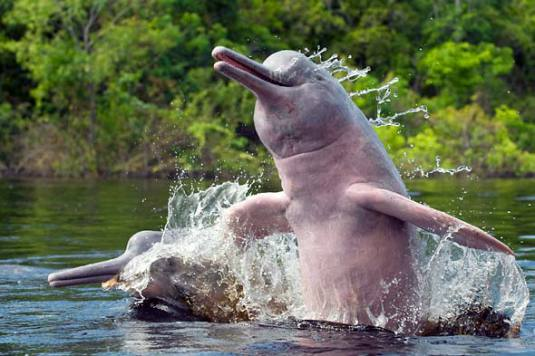The Vanishing Echoes of the Ganges River Dolphin
Dolphins, among the most intelligent creatures on Earth with a history dating back almost 50 million years, face a grim reality today. The Ganger River Dolphin, first discovered in 1801, is now endangered due to ecological damage caused by human activities.

Ganges River Dolphin | Source: Lakes of India
Dolphins, among the oldest creatures on Earth, have survived numerous evolutions, adapting to both saltwater and freshwater environments. While oceanic dolphins are spread across the world, river dolphins, residing mostly in freshwater and saline waters, are considered sacred in India, particularly near the Ganges River. In Hindu mythology, the Ganges River Dolphin is closely associated with the Vahana of Goddess Ganga, known as Makara, a creature with a dolphin tail and a crocodile head. Described in the Rig Veda, the Ganges Dolphin, or Ganga Puputaka in Sanskrit, has historical significance.
Historically hunted for various purposes, particularly medicinal use, dolphins were protected by the Mauryan Emperor Ashoka the Great, who banned the hunting and killing of these sacred creatures. However, it was only in 1801 that Heinrich Lebeck and William Roxburgh separately sent out specimens of the dolphin for study, leading to debates over its discovery. Unfortunately, Lebeck’s published findings granted him credit as the first discoverer in 1835.
The Ganges River Dolphin is naturally blind, using ultrasonic sounds and echoes from its surroundings to detect prey. Found in the rivers of India, Bangladesh, and Nepal, these solitary creatures are typically dark grey or brownish, with an elongated snout and visible pointed teeth. Female dolphins, larger than males, give birth to a calf eight to twelve months after conceiving. While they primarily prey on other fish in the river, the recent decades have witnessed a significant decline in their population, marking them as endangered since 1996, according to the IUCN Red List.

Land Pollution Near Ganges River Causes a Threat to Marine Life | Source: The Economic Times
The decline in their numbers is primarily attributed to human activities causing ecological imbalance. Construction, industrial activities, and agricultural practices along these rivers contribute to water, land, and noise pollution. Dam construction hinders the dolphins' movement, and sand bars implemented for irrigation purposes disrupt their habitat. Overfishing, essential for the livelihood of the local population, further compounds the ecological imbalance. In light of these threats, awareness is crucial to emphasise the importance of saving these voiceless creatures.
The Indian Government has initiated Project Dolphin, announced on 15 August 2020, to conserve both oceanic and river dolphins in India. Legal measures restricting the captivity of dolphins for nefarious purposes have also been enacted. It is imperative to protect these dolphins before they vanish, becoming a mere chapter in history.


